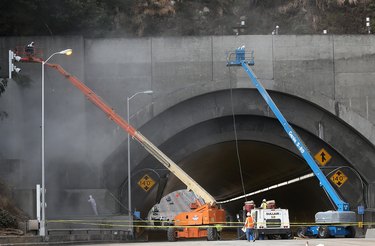Things You'll Need
6 mil plastic
Polyethylene-coated cloth duct tape
Sandblasting machine
Sand
Compressed air
Wheelbarrow
Protective clothing, hood and mask
Filtered air system

Sandblasting provides a reliable and fast way to recondition a concrete surface and remove paint or years of weathering, but it isn't a job for everyone. It's messy and noisy, and the operator of the sandblasting equipment must wear protective gear and breathe filtered air. Extensive preparation is needed when working around windows, and you must carefully clean up after sandblasting to avoid contaminating the ground or sewers. If you suspect the concrete you are conditioning to have been been painted with lead-based paint, then sandblasting is out; the high-pressure sand sends toxic lead flying into the atmosphere.
Step 1
Clear anything out of the area that you don't want covered in sand. Protect things you can't move by covering them with 6 mil plastic sheeting.
Video of the Day
Step 2
Mask windows in the path of the sandblaster with 6 mil plastic. Tape the plastic to the window frame with a double layer of polyethylene-coated cloth duct tape. Avoid using masking tape; it can come off, and if that happens while the sandblaster is nearby, the window could be ruined.
Step 3
Set up a sandblaster that mixes water with sand at the tip of the spray apparatus. This is called "wet abrasive blasting," and while it's slower than dry blasting, it avoids creating clouds of dust that can blow throughout the neighborhood.
Step 4
Shut off the valves on the sandblasting machine and fill the tank with sand. You can choose from different kinds of sand -- some are more angular than others and cut more quickly. Purchase filtered sand that has no large grains or foreign debris.
Step 5
Turn on the compressor and adjust the pressure to 40 to 50 psi. Hold the tip of the sprayer 8 to 16 inches away from your body and point it at the concrete. Depress the trigger to begin sandblasting. Adjust the pressure upward -- to a maximum of 100 psi -- until the sand cleans the concrete when you hold the nozzle about 12 inches from it.
Step 6
Move the sprayer in a sweeping horizontal motion as you would if you were spraying paint, but about half as quickly. Let the sprayer linger in corners or on areas with stubborn dirt to clean them thoroughly.
Step 7
Blow off the surface with compressed air after you're finished sandblasting. Collect all the used sand in a wheelbarrow and haul it away.
Tip
If the sand is mixed with paint chips, plaster or stucco, collect it in bags and dispose of it as hazardous waste.
You need to wear a hood, facemask and protective clothing while sandblasting, and you need a respirator connected to a positive-pressure air filtration system.
If you're working indoors, provide as much ventilation as possible by opening doors and windows and using fans.
Warning
If you're sandblasting your house, be sure to tell your neighbors well in advance. The procedure is loud and impossible to ignore.
Video of the Day